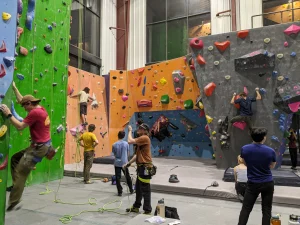Indoor climbing has become one of the most exciting and rewarding ways to stay fit, build strength, and challenge both the mind and body. Whether you’re a seasoned climber or a total beginner, choosing the right climbing facility can make all the difference in your experience. From the quality of walls to community atmosphere, every detail contributes to how enjoyable — and safe — your sessions will be.
If you’re searching for a place that combines top-tier design, safety, and community spirit, this guide breaks down the essential features to look for in a climbing gym. A great example of these qualities can be found at Bar d’escalade Vertical Bloc, where modern design meets an energetic and inclusive climbing environment.
1. Variety of Climbing Walls and Routes
A top-notch climbing gym offers a diverse range of walls that cater to all skill levels — from complete beginners to advanced climbers.
1.1 Bouldering Walls
Bouldering involves short climbs without ropes, focusing on power and technique. A great gym provides well-padded floors and walls of varying angles — vertical, slab, overhangs, and caves — to keep things challenging and exciting.
1.2 Top-Rope and Lead Climbing Walls
If you enjoy higher climbs, check whether the facility offers top-rope or lead climbing. These walls typically range from 30 to 50 feet and allow for endurance and rope-handling skill development.
1.3 Route Variety
Routes should be frequently updated to maintain variety and keep climbers motivated. Good climbing gyms reset their routes every few weeks, ensuring you always face fresh challenges.
2. Expert Route Setting
The quality of route setting determines how engaging your climbing experience will be. Look for gyms that employ experienced route setters who design climbs that are not just physically demanding but also mentally stimulating.
A great route offers multiple solutions — encouraging creativity and improving technique. The routes should also be graded fairly, helping climbers progress systematically.
3. Clean and Safe Environment
Safety and cleanliness are non-negotiable when it comes to climbing.
3.1 Proper Padding
High-quality crash mats are essential for preventing injuries during bouldering sessions. They should be thick, continuous, and well-maintained.
3.2 Equipment Maintenance
If the gym provides harnesses, ropes, and belay devices, ensure they are regularly inspected and replaced when worn.
3.3 Hygiene
With so many shared surfaces, cleanliness matters. A good gym maintains high standards of hygiene — with frequent wall cleaning, hand sanitizing stations, and good ventilation.
4. Qualified and Friendly Staff
A great climbing facility isn’t just about walls — it’s about people. Staff should be knowledgeable, approachable, and passionate about climbing.
4.1 Instructors and Trainers
Certified climbing instructors ensure you learn proper technique, safety protocols, and efficient movement. They can guide both beginners and advanced climbers in achieving their goals.
4.2 Welcoming Atmosphere
Friendly staff create an inclusive, community-driven environment where everyone — from first-timers to experts — feels comfortable.
5. Training and Fitness Areas
A well-rounded climbing gym includes more than just walls. Complementary training spaces help climbers improve strength, flexibility, and endurance.
5.1 Hangboards and Campus Boards
These tools help develop grip strength and finger endurance, key for advanced climbing.
5.2 Weights and Cardio Equipment
A small fitness zone allows you to work on overall conditioning, injury prevention, and balance.
5.3 Stretching and Yoga Spaces
Many climbers use yoga for flexibility and recovery. A designated area for stretching or classes adds value to the experience.
6. Social and Community Environment
Climbing is as much a social activity as it is a sport. The best gyms foster a sense of belonging among members.
6.1 Community Events
Workshops, competitions, and social climbs bring people together and keep motivation high.
6.2 Café or Lounge Area
Having a relaxed space to unwind after a climb encourages connection. A comfortable café or lounge lets climbers socialize, share tips, or simply refuel with a post-workout snack.
Bar d’escalade Vertical Bloc, for example, perfectly combines athletic and social energy — offering a lively, welcoming atmosphere where climbers can connect both on and off the wall.
7. Accessibility and Convenience
A great climbing facility should be easily accessible and designed for convenience.
7.1 Location and Parking
Choose a gym located near public transportation or with ample parking options.
7.2 Hours of Operation
Flexible opening hours — including evenings and weekends — make it easier to fit climbing into your schedule.
7.3 Equipment Rentals
For beginners or travelers, having rental options for shoes, chalk, and harnesses is a major plus.
8. Modern Amenities
Small details can make your climbing experience far more enjoyable. Look for:
- Clean, well-equipped changing rooms.
- Showers and lockers.
- Climate control for year-round comfort.
- Wi-Fi and work-friendly spaces for those who like to combine training and productivity.
The best gyms are designed to be welcoming spaces where you can spend several hours comfortably — training, relaxing, and socializing.
9. Options for All Skill Levels
Whether you’re taking your first step onto a climbing wall or preparing for outdoor expeditions, a good facility should have classes and programs tailored to your skill level.
9.1 Introductory Courses
Beginners benefit from guided sessions on safety, belaying, and movement fundamentals.
9.2 Advanced Workshops
Experienced climbers can focus on improving dynamic techniques, endurance, and competition-level strategies.
9.3 Youth and Family Programs
A family-friendly climbing center with youth programs encourages the next generation of climbers to develop confidence and coordination in a safe environment.
10. Community Values and Sustainability
More gyms are now integrating eco-friendly initiatives — such as recycling programs, sustainable building materials, and low-waste operations. Supporting a facility that prioritizes environmental responsibility aligns with the outdoor climbing ethos of respecting nature.
Additionally, a strong sense of community — with diversity, inclusivity, and teamwork — enhances the overall experience for everyone.
Conclusion
Choosing the right climbing gym isn’t just about walls — it’s about finding a place that inspires progress, connection, and fun. The best climbing facilities balance technical excellence with an inviting atmosphere, ensuring climbers of all levels feel both challenged and supported.






More Stories
Boost Your Health and Fitness with Phigolf 2
The Future of Interactive Sports Broadcasting: Trends to Watch